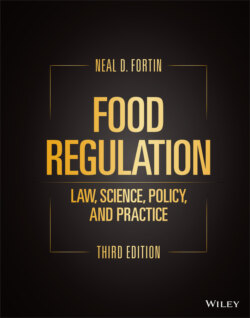Читать книгу Food Regulation - Neal D. Fortin - Страница 130
NOTES
Оглавление1 3.12 Food Waste Reduction. According to the USDA, consumers are responsible for nearly 90 billion pounds of food waste each year, which equates to 20 percent of the U.S. food supply. While perfectly good food goes to waste, approximately 40 million Americans are food insecure. USDA, EPA, and FDA announced a partnership, formalizing education and outreach efforts as part of a larger effort, which aims to reduce food loss and waste through community investments, education and outreach, voluntary programs, public–private partnerships, tool development, technical assistance, event participation, and policy discussion. The announcement comes on the heels of ongoing congressional efforts to address food waste, including the introduction of legislation designed to end consumer confusion by creating a national standard for date marking of food. One effort to combat food waste is encouraging manufacturers to use labels that clearly indicate when dates refer to quality, rather than safety, in an effort to dissuade consumers from prematurely disposing of safe food products.
2 3.13 Front‐of‐pack nutritional labeling. At least 20 front‐of‐pack (FOP) nutrition rating or guidance systems have been developed in recent years. Most were designed by food manufacturers but some by government agencies and nutrition groups. The ostensible intent is to help consumers quickly compare products’ nutritional attributes and make healthier choices. Typically, symbols are used to communicate ratings.
3 Generally, these rating systems and symbols are unregulated if not false or misleading. However, a 2009 FDA front‐of‐package labeling initiative resulted in 17 warning letters to food manufacturers for violations in these FOP labels. FDA cited unauthorized health claims and nutrient content claims but also products with nutrient content claims that failed to identify other nutrients, such as saturated fat, which were present in the products at high levels.
4 Another concern with FOP systems is how the various FOP systems focus on different nutrients. The Institute of Medicine (IOM) found that the variations in the nutrient emphasized by different systems may confuse consumers. In addition, many systems trumpet beneficial nutritional aspects, such as vitamins or fiber content, while ignoring unappealing aspects, like high sodium or sugar levels. The IOM recommended a single, consistent system that focused on information that would help consumers decrease their risk for chronic diseases. Thus, the system would need to focus on nutrients of concern for over consumption: cholesterol, sodium, saturated fat, and calories. Of course, most food companies would prefer an affirmative approach rather than a “Tell us how your product is bad for us” approach. INSTITUTE OF MEDICINE, FRONT-OF-PACKAGE NUTRITION RATING SYSTEMS AND SYMBOLS: PROMOTING HEALTHIER CHOICES (2012).
